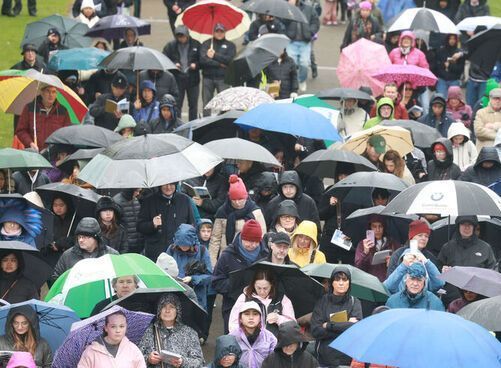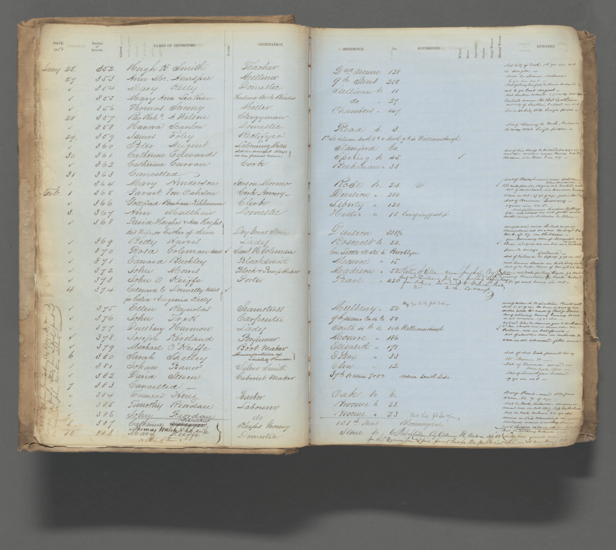The importance of the Moore Street 1916 Battlefield site was best summed up by Uachtarán na hÉireann Michael D Higgins who said: “This area belongs to no one individual, group or party. It belongs to the people."
If you want to protect this hugely important part of our revolutionary history, with its many exceptional links to the dramatic events in Dublin at Easter 1916, then support the Urgent Public Meeting being held by the Moore Street Preservation Trust in Liberty Hall, Dublin on February 23. Belfast film maker Seán Murray will produce a short documentary with Oscar nominated actor Stephen Rea to be launched in the Urgent Public Meeting.
The London-based developer Hammerson, whose proposals would destroy much of the terrace and the significant laneways around it, and the government which supports it, believe Moore Street and its environs exist to be exploited and developed in the interests of profit.
The Hammerson plans, if they go ahead, would dramatically alter the streetscape from what it was in 1916, demolish much of the area, including historic and significant buildings, and overshadow the terrace 10-25 Moore Street – the last meeting place of the 1916 leaders and GPO garrison - with high rise buildings.
Three months ago, Dublin City councillors voted unanimously to add six key buildings on Moore Street, associated with 1916 to the Record of Protected Structures. According to a report prepared for the council some of the buildings contained "creep holes" that were made during the evacuation from the GPO by the fleeing Volunteers to allow ease of movement between the buildings on the terrace.
The developer, Hammerson and Associates, claimed that it would be "inappropriate and unlawful" for the council to take this decision. Dublin City councillors rejected the Hammerson assertion saying that the council was not prevented from adding a building to the protected structures list while planning applications are pending. The council said that there was “long-standing and historic interest in considering the protection of 1916 buildings located on Henry Place and Moore Street.” The council voted to give full protection to Numbers 10 and 20/21 Moore Street and partial protection to other important buildings.
Dublin Central GP Ltd (DCGP), a subsidiary of Hammerson, has lodged judicial review proceedings in the High Court against the council. As well as accusing Dublin City Council of “inappropriate and unlawful actions" it claimed that its objective was to “sensitively rejuvenate this historic part of the city, while ensuring its long standing traditions and important heritage can be retained and celebrated.”
This claim was dismissed by James Connolly Heron, a great grandson of 1916 leader James Connolly, and a representative of the Moore Street Preservation Trust. He described the Hammerson decision to seek a judicial review as “a breathtaking disregard for the historic importance of the last extant 1916 battleground in the city.”
The Moore Street Preservation Trust, along with the Relatives of the Signatories and other groups and individuals has been campaigning to protect what the National Museum of Ireland has described as the “most important historic site in modern Irish history.”
Its importance was underlined by the High Court in 2016 which described Moore Street as unique. The Court described Moore Street as “the place to which the men and women of the GPO fled, where battle was done and surrender was negotiated, and a site where workers, civilian and combatant, lived and died in what was, to a large extent, a workers’ rising.”
From Tom Clarke’s shop on Parnell Street; to the GPO, to Henry Street where the Proclamation was signed, to Moore Lane and Moore Street where the GPO Garrison retreated, to the spot where "The O'Rahilly" died, to the Rotunda where the garrison was held by the British, and where the volunteers were founded three years earlier: these are all places intimately connected to the Rising and to the men and women who participated in it.
The Moore Street Preservation Trust plan to develop The 1916- Moore Street Quarter will be presented by Seán Antóin Ó Muiri at the Liberty Hall meeting.
Moore Street and its environs are the heart and soul of the 1916 Rising. These buildings and back lanes provide a tangible link with 1916, to the courage of those who participated in it and the vision of the leaders who produced the Proclamation of the Irish Republic. But if consumerism and the rush to profit have their way the buildings and lanes around Moore Street will be obliterated.
There are no circumstances, no situation, no justification, for allowing the demolition of any part of this historic quarter. So, on February 23, if you can, get to Liberty Hall for the next stage in the campaign to develop a 1916-Moore Street Quarter. Or log on to https://www.facebook.com/MooreStreetTrust/
PRISON BOOKS
News that some books have been banned by the Prison Service in the North comes as no surprise. The books are "Joe Cahill: A life in the IRA." Joe would be amused. "Dessie: The life and Legacy of Volunteer Dessie Grew," and "No Greater Love." The Memoirs of Seamus Kearney.
The banning of these books is stupid. No accident that they are written by, or about, republicans. Former prisoner and hunger striker Pat Sheehan MLA has written to the prison authorities seeking the unbanning of these titles. Good man Pat.
I love books. Ever since my granny took me to the Falls Library when I was a wee lad I have loved books. She used to go to the library most weeks to exchange her reading material and I would potter along with her. I recall being amazed at the serried rows of shelved tomes and the quiet hush in the reading room. I quickly graduated to reading books myself. By the time I was ten I was a bookworm.
That’s why I wear glasses. The first and only youngster of our clan to do so. Though all my siblings wear them these days.
A decade or so later I ended up on The Maidstone Prison Ship in Belfast Lough. I don’t recall reading any books there. We were below decks and the lighting was poor and we were on protest most of the time. We succeeded in getting the Maidstone closed down.
Later, in Long Kesh, the censors restricted the books permitted in the cages. But most cages had a steady flow of reading material doing the rounds. We were internees, so the rules were slightly different to the regime for remand or sentenced prisoners.
A few years later I was in Belfast Prison. It was a madhouse at that time. Overcrowded, dangerous, brutal and oppressive. But it had a "library." Well, it had a store room containing books left by prisoners over the years. Mostly paperbacks. Thrillers and crime or cowboy novels. I read one or two books a day. There was nothing else to do. We were locked up most days. Three in a cell. My two cellmates were younger than me and they were addicted to DownTown Radio played loudly. So the daily dose of books helped me retain my sanity.
In Cage Eleven we had our own reading circle. We cancelled our food parcels for a few weeks and our ever supportive families sent us in a few quid instead. We then ordered political books from The Connolly Association in London, and from old Joe Clarke in Dublin. The censor banned some books but we found ways to smuggle them in and they were devoured and analyzed by a cohort of comrades including mé féin, Bobby Sands, Cleaky, Danny Lennon, Brendan Hughes, Hugh Feeney, Floorboards and other prisoners.
Later again I ended up in the H Blocks for a wee while. No books there except "The Bible." As well as being well read by some, its thin pages were also utilized for rolling tobacco if cigarette papers were in short supply. We also had miniatures of republican papers smuggled in to keep us up to date with developments outside.
Incidentally, I wrote a book while in Cage Eleven. Danny Devenny did illustrations and graphics. We smuggled it out to Tom Hartley. It was never published. But that’s another story.
DONEGAL PEOPLES' ASSEMBLY
On Tuesday, February 13, have your say in the exciting discussion on the future of Ireland. The Donegal Peoples' Assembly will take place at 7 p.m. in the Balor Theatre, Ballybofey.
Opening remarks will be by Pearse Doherty TD and the independent chairperson is Mícheál Ó hÉanaigh, the former CEO of Údarás na Gaeltachta and a former Director of Services with Donegal County Council. There will be a panel of well known Donegal people. The Assembly will explore the opportunities and options for Donegal and for Ireland for the future.
If you can make it come to the Balor Theatre on February 13. If that’s not possible you can still "Have Your Say" by making a written contribution at www.sinnfein.ie/futureofireland Look forward to seeing you in the Balor Theatre in Ballybofey on 13 February. Bígí linn.








